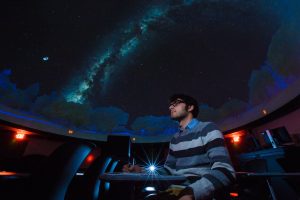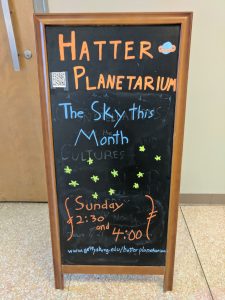 We’re excited to bring you another semester of free digital planetarium shows, starting Sunday, January 28. The four “Sky this Month” shows will cover what you can see from your yard as well as current astronomy news. “Constellations across the Cultures” is a show we produced ourselves last year. Brand new in April will be our new full-dome show on the topic of time, now in production. We’ll use the full-dome, immersive environment of the planetarium to explore the subject of time and timekeeping from sundials to relativity, with insights from Gettysburg College faculty. Written and produced by Gettysburg College students and staff.
We’re excited to bring you another semester of free digital planetarium shows, starting Sunday, January 28. The four “Sky this Month” shows will cover what you can see from your yard as well as current astronomy news. “Constellations across the Cultures” is a show we produced ourselves last year. Brand new in April will be our new full-dome show on the topic of time, now in production. We’ll use the full-dome, immersive environment of the planetarium to explore the subject of time and timekeeping from sundials to relativity, with insights from Gettysburg College faculty. Written and produced by Gettysburg College students and staff.
The Sky this Month
- January 28, 2:30
- January 28, 4:00
- February 1, Noon
Constellations across the Cultures (Our Own Production from Spring 2017)
- February 18, 2:30
- February 18, 4:00
- February 22, Noon
The Sky this Month
- March 4, 2:30
- March 4, 4:00
- March 8, Noon
The Sky this Month
- March 25, 2:30
- March 25, 4:00
- March 29, Noon
Our Own New Production on the Topic of TIME, Title TBA
- April 15 , 2:30
- April 15, 4:00
- April 19, Noon
The Sky this Summer
- April 29, 2:30
- April 29, 4:00
- May 3, Noon
Here’s the schedule in PDF form: Hatter_Schedule_S18







